初中英语动词讲解
初中英语动词及动词短语考点
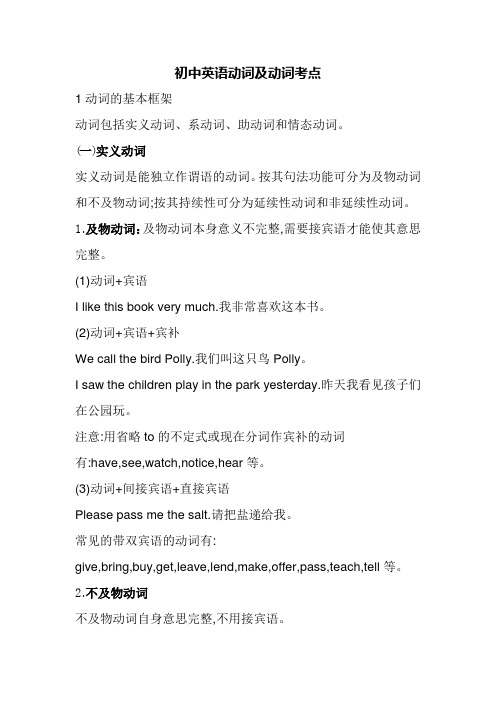
初中英语动词及动词考点1动词的基本框架动词包括实义动词、系动词、助动词和情态动词。
(一)实义动词实义动词是能独立作谓语的动词。
按其句法功能可分为及物动词和不及物动词;按其持续性可分为延续性动词和非延续性动词。
1.及物动词:及物动词本身意义不完整,需要接宾语才能使其意思完整。
(1)动词+宾语I like this book very much.我非常喜欢这本书。
(2)动词+宾语+宾补We call the bird Polly.我们叫这只鸟Polly。
I saw the children play in the park yesterday.昨天我看见孩子们在公园玩。
注意:用省略to的不定式或现在分词作宾补的动词有:have,see,watch,notice,hear等。
(3)动词+间接宾语+直接宾语Please pass me the salt.请把盐递给我。
常见的带双宾语的动词有:give,bring,buy,get,leave,lend,make,offer,pass,teach,tell等。
2.不及物动词不及物动词自身意思完整,不用接宾语。
Horses run fast.马跑得快。
(1)有些动词既可作及物动词又可作不及物动词。
We study English.我们学习英语。
(及物动词)We study hard.我们努力学习。
(不及物动词)(2)有些不及物动词与一些别的词搭配在一起构成动词短语,它的作用相当于一个及物动词。
①动词+介词Listen to the teacher carefully.仔细听老师讲。
此类动词短语后面的宾语无论是名词还是代词,都只能放在介词后面,不能放在动词和介词之间。
②动词+副词+介词Let’s go on with our work!让我们继续我们的工作吧!He gets along well with his classmates.他与他的同学们相处得很好。
初中英语语-动词详解

与主语在数上一致
He writes well. 第三人称单数
时态
表示动作发生的时间
He wrote a letter to me last month. 过去时态
语态
主语是动作的发生者或者承受者
We study English.主动 The road was filled with rubbish. 被动
②与表示时间或条件的状语从句连用。If you ask him, he will help you.
③ 用于"I expect, I'm sure, I think, I wonder + 宾语从句"中。 I don't think the test will be very difficult.
3.一般将来时
不能独立做谓语,跟主要动词构成谓语,表示疑问,否定及各种时态
He doesn’t speak Chinese. I am watching TV.
情态动词 (mod. v.)
跟动词原形(有自己的词汇意思)
不能独立做谓语。表示说话人语气、情态,无人称和数的变化
We can do it by ourselves. That would be better.
6.现在完成时
A)选用have, has填空: 1.I _______ told him the news. 2.She ________ come back from school. 3.You ________ won the game.
一、按词义和句中的作用,动词可以分为四类
构成方式
举例
动词+介词
Look at, look after
初中英语语法:动词种类篇

初中英语语法:动词种类篇初中英语语法:动词种类篇动词的种类动词是表示动作或状态的词,按其词义和在句子中的作用可分为行为动词,连系动词,助动词和情态动词。
1.行为动词行为动词可分为及物动词 (vt)和不及物动词(vi),及物动词表示动作或状态,有完好的词义,能单独作谓语,后跟宾语;不及物动词表示动作或状态,有完好的词义,能单独作谓语,但后面不能直接跟宾语,如要带宾语那么与介词或副词构成短语。
如:More and more people study English.(vt)The students are listening to the teacher carefully.(vi)2.连系动词连系动词本身有一定的词义,但不能独立作谓语,必须与表语一起构成谓语。
常用的'连系动词有 be, get, turn, bee, look, feel, grow, seem, sound, taste, smell等。
如:Our country is being stronger and stronger.It feels d.3.助动词助动词本身无词义,不能单独作谓语,只能和主要动词一起构成谓语动词,表示否认,疑问及动词的时态、语态、人称和数等语法特征,助动词有 be,do,have,shall,will等。
如:How do you usually e to school?The children are playing yo-yo now.4.情态动词情态动词本身有一定的意义,但不能独立作谓语,只能和主要动词原形一起构成谓语,表示说话人的语气和情态。
情态动词没有人称和数的变化。
情态动词有 can(could),may(might),must, need, ought to, dare等。
如:Can I help you?- Must we go now? -No, you needn't .a. can与be able to的用法有所区别。
初中英语语法知识梳理 ——动词
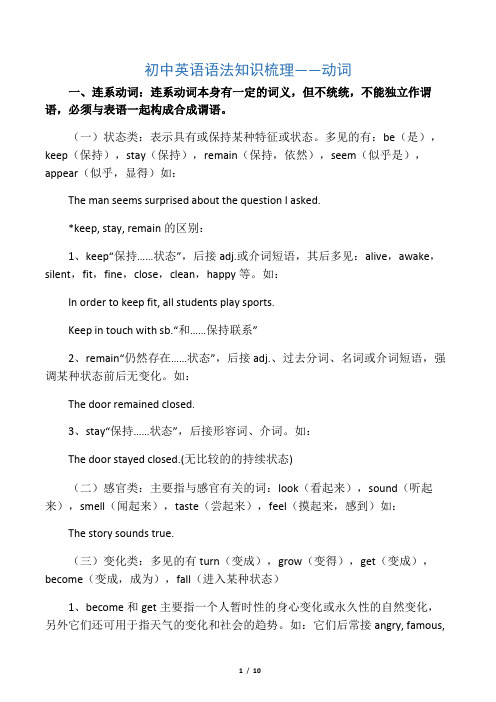
初中英语语法知识梳理——动词一、连系动词:连系动词本身有一定的词义,但不统统,不能独立作谓语,必须与表语一起构成合成谓语。
(一)状态类:表示具有或保持某种特征或状态。
多见的有:be(是),keep(保持),stay(保持),remain(保持,依然),seem(似乎是),appear(似乎,显得)如:The man seems surprised about the question I asked.*keep, stay, remain的区别:1、keep“保持……状态”,后接adj.或介词短语,其后多见:alive,awake,silent,fit,fine,close,clean,happy等。
如:In order to keep fit, all students play sports.Keep in touch with sb.“和……保持联系”2、remain“仍然存在……状态”,后接adj.、过去分词、名词或介词短语,强调某种状态前后无变化。
如:The door remained closed.3、stay“保持……状态”,后接形容词、介词。
如:The door stayed closed.(无比较的的持续状态)(二)感官类:主要指与感官有关的词:look(看起来),sound(听起来),smell(闻起来),taste(尝起来),feel(摸起来,感到)如:The story sounds true.(三)变化类:多见的有turn(变成),grow(变得),get(变成),become(变成,成为),fall(进入某种状态)1、become和get主要指一个人暂时性的身心变化或永久性的自然变化,另外它们还可用于指天气的变化和社会的趋势。
如:它们后常接angry, famous,ill, old, well, deaf, strong等。
如:get dressed穿衣服2、grow“渐渐变得……起来,长得”,主要表示逐渐变化,强调变化的过程。
初中英语情态动词的讲解

初中英语情态动词的讲解情态动词是英语中的一类特殊动词,用于表示说话人的态度、推测、能力、许可等。
初中阶段研究英语时,情态动词是一个重要的语法知识点。
本文将对初中英语中常用的情态动词进行讲解。
1. CanCan 是一个情态动词,用于询问和表示能力、可能性、允许等。
是一个情态动词,用于询问和表示能力、可能性、允许等。
1.1 用法- 用于询问能力:Can 用于询问某人是否有能力做某事。
Can用于询问某人是否有能力做某事。
- Can you swim?(你会游泳吗?)- 用于表示可能性:Can 用于表示某事有可能发生。
Can用于表示某事有可能发生。
- It can rain tomorrow.(明天可能会下雨。
)- 用于征求允许:Can 用于请求允许做某事。
Can用于请求允许做某事。
- Can I borrow your pen?(我可以借用你的钢笔吗?)1.2 注意事项- 当 Can 用于疑问句时,其后的动词需用原形。
Can用于疑问句时,其后的动词需用原形。
- Can she play the guitar?(她会弹吉他吗?)2. MustMust 是一个情态动词,用于表示必须,义务和推测。
是一个情态动词,用于表示必须,义务和推测。
2.1 用法- 用于表示必须:Must 用于表示某事是必须的。
Must用于表示某事是必须的。
- You must finish your homework before watching TV.(你必须在看电视之前完成作业。
)- 用于表示义务:Must 用于表示某事是责任所在。
Must用于表示某事是责任所在。
- We must obey the rules.(我们必须遵守规则。
)- 用于表示推测:Must 用于表示一种较为确信的推测。
Must用于表示一种较为确信的推测。
- He must be tired after running for so long.(他跑了这么长时间,一定很累了。
初中英语知识点总结:动词知识点总结

初中英语知识点总结:动词知识点总结一、关键信息1、动词的定义和分类实义动词系动词助动词情态动词2、动词的时态一般现在时一般过去时一般将来时现在进行时过去进行时现在完成时过去完成时过去将来时3、动词的语态主动语态被动语态4、动词的非谓语形式动词不定式动名词分词(现在分词和过去分词)二、动词的定义和分类11 实义动词实义动词是表示具体动作或状态的动词,具有实际的意义。
实义动词又可分为及物动词和不及物动词。
111 及物动词及物动词后面需要接宾语,才能完整地表达意思。
例如:“I love you” 中的“love”就是及物动词,“you”是宾语。
112 不及物动词不及物动词后面不需要接宾语就能表达完整的意思。
例如:“He runs fast” 中的“runs”就是不及物动词。
12 系动词系动词用于连接主语和表语,说明主语的性质、状态、特征等。
常见的系动词有 be(am/is/are/was/were)、seem、look、feel、sound、taste、smell 等。
例如:“She is beautiful” 中的“is”就是系动词。
13 助动词助动词本身没有实际意义,主要用于协助主要动词构成各种时态、语态、语气等。
常见的助动词有do/does/did、have/has/had、will/would、shall/should 等。
例如:“He doesn't like sports” 中的“doesn't”就是助动词。
14 情态动词情态动词表示说话人的态度、情感或推测等。
常见的情态动词有can/could、may/might、must、need、should、ought to 等。
情态动词后面接动词原形。
例如:“You must study hard” 中的“must”就是情态动词。
三、动词的时态11 一般现在时表示经常发生的动作、习惯性的动作或客观事实、真理等。
其构成是主语+动词原形(当主语是第三人称单数时,动词要加 s 或 es)。
初中英语语法——动词(共33张)ppt课件

2.情态动词:首先要记住情态动词后必跟动词原形。意思是"应当,必须",侧重于说话者的主观看法,没有时态变化,其否定式 是mustn't,在"Must I(we) ...."的疑问句中,须注意的是其否定回答常用needn't。 如:Must I go?(我一定要走吗?) No, you needn't.(不,不必。)
谢谢
初中英语语法——动词(共 33张)ppt课件
演讲人
动词是表示人或事物的动作、存在、变化的词。
1.系动词:大概是最简单的动词了。你只需注意的是系动词除了be的形式之外,还 有become,get,grow,turn,sound,look,smell,taste等,它们不能单独 作谓语,必须和作表语的词语(如形容词, 名词等) 连用, 所以用的时候,可要小心为是 呀!如:It smells delicious.(它闻起来味道很美)。delicious 是形容词,不是副词。
4.感官动词:see, watch, notice, look at, hear, listen to, smell, taste, feel 等 +do 表示动作的完整性,真实性 +doing 表示动作的连续性,进行性。如:I saw him work in the garden yesterday. 昨天我看见他在花园里干活了。(强调"我看 见了"这个事实) I saw him working in the garden yesterday.(强调"我见他正干活"这个动作)昨天我见他正在花园里 干活。
need意为"需要"。既可作实义动词,又可作情态动词,因此在用法上需要注意。作 实义动词时,need后跟名词,动名词,或不定式。如:I need to go. (我得走了。) 作情态动词时,后跟动词原形。如:You needn't come tomorrow if you are busy. (如果你忙,明天就不必来了。)
初中英语动词讲解及例句

3、can只有现在 时和过去时,其 他时态要用 be able to。
教学资料整理
• 仅供参考,
I live in Beijing with my mother. 我 和我妈妈住在北京。live,住 It has a round face.(它有一张圆 脸。)has,有
连系动词
连系动词是表示主语“是什么”或 “怎么样”的词,它虽有词义,但 不完整,所以不能单独作谓语,必 须跟表语一起构成合成谓语, 例如:We are in Grade Two this year. 今年我们在两年级.are,是 are 这个词的词义“是”在句子中常 常不译e, could, might等。它们不能单独作谓语, 必须与行为动词(原形)一起作 谓语,表示完整的意思,
例如:
He can’t walk because he is a baby.(因为他是个婴 儿,不会走路。)can’t, 不 必 May I come in?(我可以 进来吗?)may, 可以
表示“感觉”的词,如look(看 起来),feel(觉得,摸起来), smell(闻起来),sound(听起 来),taste(尝起来) 表示“变”、“变成”的意思的 词,如become, get, grow, turn, 都解释为“变”、“变得”,
它们既可以作为行为动词,又可 以作为连系动词look,fell,smell
He can borrow some books from the library.(他可以从图书
馆借到一些书。)can, 可以 2、I run fast.(我跑得快。) I can’t run fast(我跑得不快。)
can’t, 不会,不能
3、Must he go now(他必须现 在走吗?)must, 必须
初中英语300动词详解(一)——do的用法(越简单越复杂)
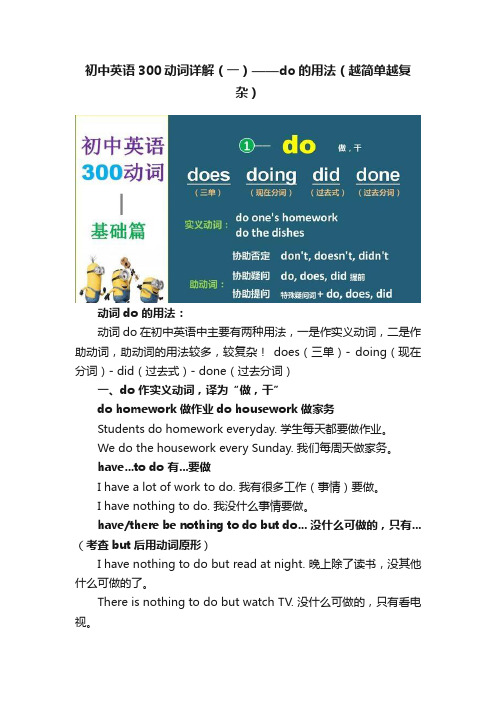
初中英语300动词详解(一)——do的用法(越简单越复杂)动词 do 的用法:动词 do 在初中英语中主要有两种用法,一是作实义动词,二是作助动词,助动词的用法较多,较复杂!does(三单)- doing(现在分词)- did(过去式)- done(过去分词)一、do 作实义动词,译为“做,干”do homework 做作业 do housework 做家务Students do homework everyday. 学生每天都要做作业。
We do the housework every Sunday. 我们每周天做家务。
have...to do 有...要做I have a lot of work to do. 我有很多工作(事情)要做。
I have nothing to do. 我没什么事情要做。
have/there be nothing to do but do... 没什么可做的,只有...(考查but后用动词原形)I have nothing to do but read at night. 晚上除了读书,没其他什么可做的了。
There is nothing to do but watch TV. 没什么可做的,只有看电视。
do well in 擅长于... 等于 be good at(后接 sth. 或 doing)Tom does well in math. Tom擅长数学。
= T om is good at math.My sister does well in swimming. 我妹妹擅长游泳。
= My sister is good at swimming.When I was young, I did well in English. 我小的时候擅长学数学。
have...to do with... 与...有关系The man have a lot to do with the accident. 这个男人与事故有很大关系。
初中英语知识点总结:动词
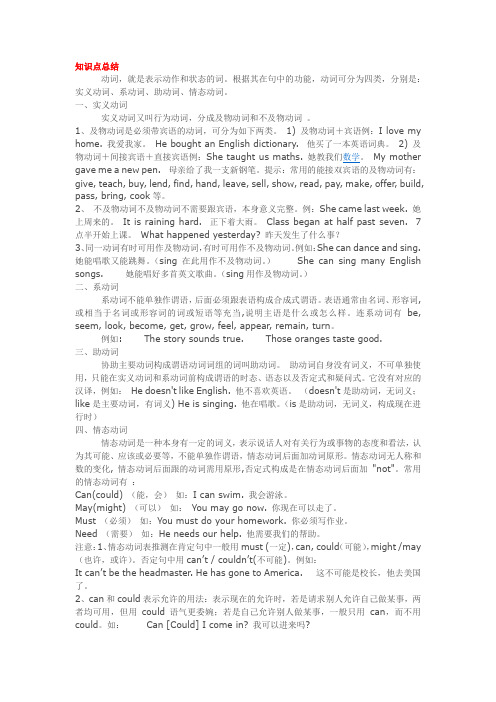
知识点总结动词,就是表示动作和状态的词。
根据其在句中的功能,动词可分为四类,分别是:实义动词、系动词、助动词、情态动词。
一、实义动词实义动词又叫行为动词,分成及物动词和不及物动词。
1、及物动词是必须带宾语的动词,可分为如下两类。
1) 及物动词+宾语例:I love my home. 我爱我家。
He bought an English dictionary. 他买了一本英语词典。
2) 及物动词+间接宾语+直接宾语例:She taught us maths. 她教我们数学。
My mother gave me a new pen. 母亲给了我一支新钢笔。
提示:常用的能接双宾语的及物动词有:give, teach, buy, lend, find, hand, leave, sell, show, read, pay, make, offer, build, pass, bring, cook等。
2、不及物动词不及物动词不需要跟宾语,本身意义完整。
例:She came last week. 她上周来的。
It is raining hard. 正下着大雨。
Class began at half past seven. 7点半开始上课。
What happened yesterday? 昨天发生了什么事?3、同一动词有时可用作及物动词,有时可用作不及物动词。
例如:She can dance and sing.(sing在此用作不及物动词。
)She can sing many English songs. 她能唱歌又能跳舞。
她能唱好多首英文歌曲。
(sing用作及物动词。
)二、系动词系动词不能单独作谓语,后面必须跟表语构成合成式谓语。
表语通常由名词、形容词,或相当于名词或形容词的词或短语等充当,说明主语是什么或怎么样。
连系动词有be, seem, look, become, get, grow, feel, appear, remain, turn。
初中英语语法大全动词的概述
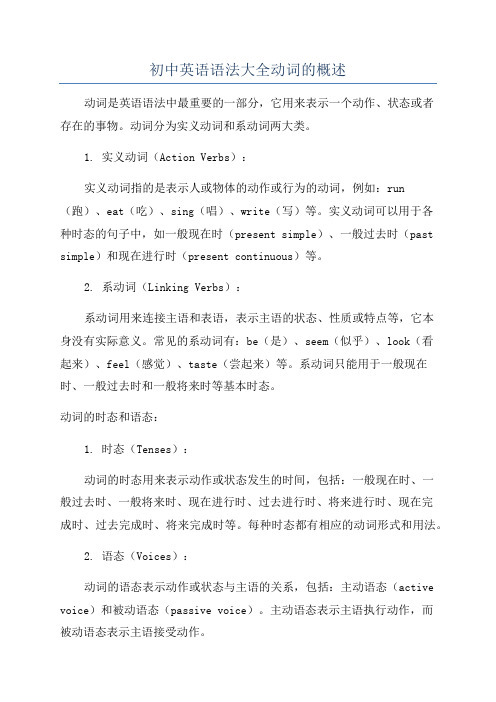
初中英语语法大全动词的概述动词是英语语法中最重要的一部分,它用来表示一个动作、状态或者存在的事物。
动词分为实义动词和系动词两大类。
1. 实义动词(Action Verbs):实义动词指的是表示人或物体的动作或行为的动词,例如:run (跑)、eat(吃)、sing(唱)、write(写)等。
实义动词可以用于各种时态的句子中,如一般现在时(present simple)、一般过去时(past simple)和现在进行时(present continuous)等。
2. 系动词(Linking Verbs):系动词用来连接主语和表语,表示主语的状态、性质或特点等,它本身没有实际意义。
常见的系动词有:be(是)、seem(似乎)、look(看起来)、feel(感觉)、taste(尝起来)等。
系动词只能用于一般现在时、一般过去时和一般将来时等基本时态。
动词的时态和语态:1. 时态(Tenses):动词的时态用来表示动作或状态发生的时间,包括:一般现在时、一般过去时、一般将来时、现在进行时、过去进行时、将来进行时、现在完成时、过去完成时、将来完成时等。
每种时态都有相应的动词形式和用法。
2. 语态(Voices):动词的语态表示动作或状态与主语的关系,包括:主动语态(active voice)和被动语态(passive voice)。
主动语态表示主语执行动作,而被动语态表示主语接受动作。
动词的形式变化:1.时态、人称和数的变化:动词的形式会根据时态、人称和数的不同而发生变化。
一般而言,动词在第三人称单数形式(he/she/it)中,要在词尾加上-s或-es,如:eat(吃)→ eats(吃),go(去)→ goes(去)。
2.动词的过去式和过去分词形式:大部分动词的过去式是在词尾加-ed,如:work(工作)→ worked (工作过)。
而过去分词的形式分为规则动词和不规则动词。
规则动词在词尾加-ed,如:played(玩过),而不规则动词则没有规则可循,如:gone(去过)。
(完整版)初中英语动词时态和语态讲解

初中英语动词时态和语态讲解动词的时态和语态(一)动词是谓语动所表示的动作或情况发生时间的各种形式。
英语动词有16种时态,但是常用的只有9种:一般现在时、一般过去时、一般将来时、现在进行时、过去进行时、现在完成时、过去完成时、过去将来时、现在完成进行时。
下面分别介绍。
1、一般现在时的用法1)表示经常性、习惯性的动作;表示现在的状态、特征和真理.句中常用 often, usually, every day 等时间状语。
例如:a. He goes to school every day。
b. He is very happy。
c。
The earth moves around the sun。
2)在时间状语从句和条件状语从句中,用一般现在时表示将来。
例如:a。
If you come this afternoon,we’ll have a meeting.b. When I graduate, I'll go to countryside.3) 有时这个时态表示按计划、规定要发生的动作(句中都带有时间状语),但限于少数动词,如:begin, come, leave, go ,arrive, start , stop, return, open, close等。
例如:a. The meeting begins at seven。
b. The rain starts at nine in the morning。
4) 表示状态和感觉的动词(be, like, hate, think, remember, find, sound 等)常用一般现在进行时。
a. I like English very much。
b。
The story sound very interesting.5) 书报的标题、小说等情节介绍常用一般现在时。
2.一般现在时的用法1)表示过去某时间发生的事、存在的状态或过反复发生的动作。
初中英语语法5动词(I)
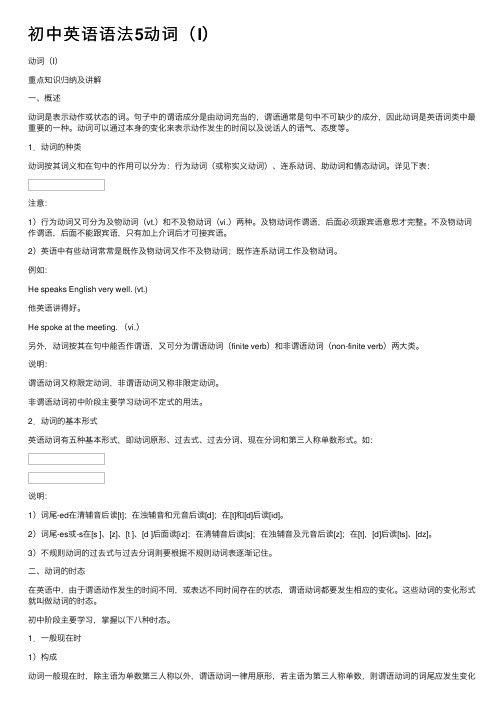
初中英语语法5动词(I)动词(I)重点知识归纳及讲解⼀、概述动词是表⽰动作或状态的词。
句⼦中的谓语成分是由动词充当的,谓语通常是句中不可缺少的成分,因此动词是英语词类中最重要的⼀种。
动词可以通过本⾝的变化来表⽰动作发⽣的时间以及说话⼈的语⽓、态度等。
1.动词的种类动词按其词义和在句中的作⽤可以分为:⾏为动词(或称实义动词)、连系动词、助动词和情态动词。
详见下表:注意:1)⾏为动词⼜可分为及物动词(vt.)和不及物动词(vi.)两种。
及物动词作谓语,后⾯必须跟宾语意思才完整。
不及物动词作谓语,后⾯不能跟宾语,只有加上介词后才可接宾语。
2)英语中有些动词常常是既作及物动词⼜作不及物动词;既作连系动词⼯作及物动词。
例如:He speaks English very well. (vt.)他英语讲得好。
He spoke at the meeting. (vi.)另外,动词按其在句中能否作谓语,⼜可分为谓语动词(finite verb)和⾮谓语动词(non-finite verb)两⼤类。
说明:谓语动词⼜称限定动词,⾮谓语动词⼜称⾮限定动词。
⾮谓语动词初中阶段主要学习动词不定式的⽤法。
2.动词的基本形式英语动词有五种基本形式,即动词原形、过去式、过去分词、现在分词和第三⼈称单数形式。
如:说明:1)词尾-ed在清辅⾳后读[t];在浊辅⾳和元⾳后读[d];在[t]和[d]后读[id]。
2)词尾-es或-s在[s ]、[z]、[t ]、[d ]后⾯读[iz];在清辅⾳后读[s];在浊辅⾳及元⾳后读[z];在[t],[d]后读[ts]、[dz]。
3)不规则动词的过去式与过去分词则要根据不规则动词表逐渐记住。
⼆、动词的时态在英语中,由于谓语动作发⽣的时间不同,或表达不同时间存在的状态,谓语动词都要发⽣相应的变化。
这些动词的变化形式就叫做动词的时态。
初中阶段主要学习,掌握以下⼋种时态。
1.⼀般现在时1)构成动词⼀般现在时,除主语为单数第三⼈称以外,谓语动词⼀律⽤原形,若主语为第三⼈称单数,则谓语动词的词尾应发⽣变化(加-s或-es)。
初中英语非谓语动词讲解

初中英语非谓语动词讲解非谓语动词是指动词在句子中不作谓语,而作其他成分或者补充说明的形式。
在英语中,非谓语动词包括动词不定式、动名词和分词。
下面将分别对这三种非谓语动词进行详细解释。
一、动词不定式(infinitive)动词不定式是以to作为标志的动词形式,通常有两种形式:一种是带有to的形式,称为带to的不定式;另一种是省略to 的形式,称为不带to的不定式。
带to的不定式的用法包括:1. 作为动词的宾语,如:She agreed to help me.2. 作为动词的补语,如:I want to be a teacher.3. 用于某些固定的动词后面,如:She promised to come early.4. 用于某些形容词后面,如:I am happy to see you.不带to的不定式的用法包括:1. 作为句子的主语,如:To learn a foreign language is important.2. 作为动词的宾语,如:She made him clean the room.3. 作为某些动词后的宾补,如:We saw him leave the house.动词不定式还有时态和语态的变化,例如:一般式:to do完成式:to have done被动式:to be done二、动名词(gerund)动名词是动词加上-ing形式构成的名词,它既具有动词的特点,又具有名词的特点。
动名词的用法包括:1. 作为动词的主语,如:Swimming is good exercise.2. 作为动词的宾语,如:I enjoy swimming in the summer.3. 作为介词的宾语,如:She is good at playing the piano.动名词也可以带有物主代词、名词性物主代词或名词作定语,如:I appreciate your helping me.三、分词(participle)分词是由动词的-ing或-ed形式构成的,它可以用作动词的形容词化形式,表示被动意义或者作为形容词修饰名词。
初中英语动词的分类知识点概述

初中英语动词的分类知识点概述一、实义动词图片1. 英语的实义动词又可分为及物动词和不及物动词两大类:后面必须跟宾语意义才完整的叫及物动词;本身意义完整,后面不需跟宾语的叫不及物动词。
2. 有些动词通常只作不及物动词。
如:go, come, happen, lie, listen, rise, arrive, hall 等。
有些动词通常用作及物动词。
如:say, raise, lay, find, buy等。
3. 大多数动词可以兼作及物动词和不及物动词。
如:study, sing, speak等。
例如:Who is going to speak at the meeting?谁打算在会上发言?(speak作不及物动词)Few people outside China speak Chinese.在中国以外很少人讲汉语。
(speak作及物动词)4. 有些动词作及物动词与作不及物动词时的意义有所不同。
如:know, wash等。
例如:It’s your turn to wash dishes.轮到你洗碗了。
I had to wash and dress in a hurry.我得赶紧洗漱穿衣。
5. 有些动词常和介词、副词或其它词类一起构成固定词组,形成短语动词。
如:listen, reply, wait, look等。
二、连系动词图片连系动词用来连接主语和表语,连系动词后面常为形容词。
1. 表示“是”的动词be。
这个词在不同的主语后面和不同的时态中有不同的形式,is,am,are,was,were,have / has been等要特别予以注意。
例如:He is a teacher.他是个教师。
We are Chinese.我们是中国人。
2. 表示“感觉”的词,如look(看起来),feel(觉得,摸起来),smell(闻起来),sound(听起来),taste(尝起来)等。
例如:She looked tired.她看一去很疲劳。
初中英语语法知识梳理——动词

初中英语语法知识梳理——动词一、连系动词:连系动词本身有一定的词义,但不完整,不能独立作谓语,必须与表语一起构成合成谓语。
(一)状态类:表示具有或保持某种特征或状态。
常见的有:be (是),keep (保持),stay (保持),remain (保持,依然),seem (似乎是),appear (似乎,显得)如:The man seems surprised about the question I asked.*keep, stay, remai n 的区别:1、keep “保持... 状态”,后接adj.或介词短语,其后常见:alive, awake, silent, fit, fine, close, clean, happy等。
如:In order to keep fit, all students play sports.Keep in touch with sb. “和.. 保持联系”2、remain “仍然存在.. 状态”,后接adj.、过去分词、名词或介词短语,强调某种状态前后无变化。
如:The door remained closed.3、stay “保持……状态”,后接形容词、介词。
如:The door stayed closed.无比较的的持续状态)(二)感官类:主要指与感官有关的词:look (看起来),sou nd (听起来),smell (闻起来),taste (尝起来),feel (摸起来,感到)如:The story sounds true.(三)变化类:常见的有turn (变成),grow (变得),get (变成),become (变成,成为),fall (进入某种状态)1、become和get主要指一个人暂时性的身心变化或永久性的自然变化,另外它们还可用于指天气的变化和社会的趋势。
如:它们后常接angry, famous, ill, old, well, deaf, strong等。
初中英语--动词讲解(共63张PPT)

3.动词+间接宾语+直接宾语
bring, hand, lend , mail ,offer ,owe ,pass , post ,read, return , send ,sell ,show , take ,teach ,tell , throw ,write
+ sb +sth/ sth to sb
2、不及物动词:自身意思完整,无需接 宾语。 Birds can fly.
1、动词+宾语 I like English very much. 2、动词+宾语+宾补 We call the bird Polly (n.). 加名词作宾补的词有
choose, consider, elect, make, name I would like you to come to my home tomorrow.
动词加过去分词(补语)
过去分词作宾补时,常见的词有 have ,get, make
have sth done 我理发了。 I have had my hair cut. 我让别人明白了。 I made myself heard. I made myself hear that song.
come, go, fall
go bad / hungry / mad / wrong
fall (fell-fallen) ill / asleep
※feel (felt-felt) sick / sleepy
②感观类:look, sound, feel, taste, smell
His voice sounds ________.
red, green
grow 表成长中的变化
初中英语语法专题—动词讲解
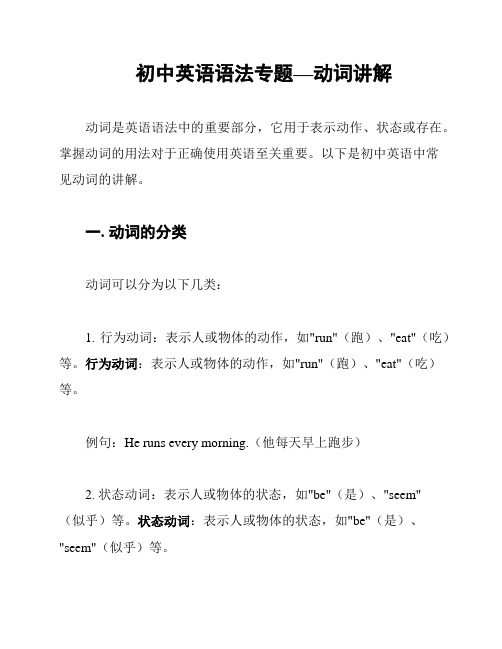
初中英语语法专题—动词讲解动词是英语语法中的重要部分,它用于表示动作、状态或存在。
掌握动词的用法对于正确使用英语至关重要。
以下是初中英语中常见动词的讲解。
一. 动词的分类动词可以分为以下几类:1. 行为动词:表示人或物体的动作,如"run"(跑)、"eat"(吃)等。
行为动词:表示人或物体的动作,如"run"(跑)、"eat"(吃)等。
例句:He runs every morning.(他每天早上跑步)2. 状态动词:表示人或物体的状态,如"be"(是)、"seem"(似乎)等。
状态动词:表示人或物体的状态,如"be"(是)、"seem"(似乎)等。
例句:She is happy today.(她今天很开心)3. 助动词:用于构成各种时态、语态和情态动词,如"be"、"do"、"have"等。
助动词:用于构成各种时态、语态和情态动词,如"be"、"do"、"have"等。
例句:I have been to London.(我去过伦敦)4. 情态动词:用于表示说话者的意图、愿望、能力、许可等,如"can"(能)、"may"(可能)等。
情态动词:用于表示说话者的意图、愿望、能力、许可等,如"can"(能)、"may"(可能)等。
例句:You can go home now.(你现在可以回家了)二. 动词的时态动词的时态用于表示动作或状态发生的时间。
常见的时态有以下几种:1. 一般现在时:表示经常性或惯性的动作或状态。
一般现在时:表示经常性或习惯性的动作或状态。
初中英语语法知识点整理总结-动词

初中英语语法知识点整理总结-动词动词是句子的中心词,用来表示人或物的动作、状态、变化等。
掌握动词的正确使用对于研究英语语法至关重要。
以下是初中英语动词知识点的整理总结:1. 动词的分类- 及物动词:表示动作的动词,需要带宾语才能构成完整的意义。
例如:read(读),eat(吃)。
- 不及物动词:表示动作的动词,不需要带宾语。
例如:run (跑),sleep(睡觉)。
- 连系动词:表示状态的动词,连接主语和表语,没有实际意义。
例如:be(是),seem(似乎)。
2. 动词的时态- 现在时:表示目前正在进行的动作或状态。
例如:I read a book.(我正在读一本书。
)- 过去时:表示过去发生的动作或状态。
例如:She ate an apple yesterday.(她昨天吃了一个苹果。
)- 将来时:表示将来要发生的动作或状态。
例如:They will go to the zoo tomorrow.(他们明天会去动物园。
)3. 动词的语态- 主动语态:表示主语是动作的执行者。
例如:Jim cleans the room.(吉姆打扫房间。
)- 被动语态:表示主语是动作的承受者。
例如:The room is cleaned by Jim.(房间被吉姆打扫了。
)4. 动词的情态- can:表示能力或许可。
例如:She can swim.(她会游泳。
)- must:表示必须。
例如:You must finish your homework.(你必须完成你的作业。
)- should:表示建议或义务。
例如:You should help others.(你应该帮助别人。
)以上是初中英语动词的一些基本知识点,希望对你的研究有所帮助。
(详细解析)初中英语动词时态和语态讲解
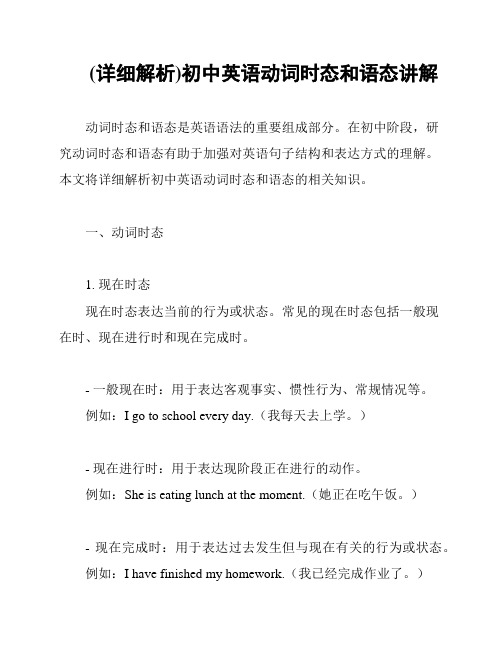
(详细解析)初中英语动词时态和语态讲解动词时态和语态是英语语法的重要组成部分。
在初中阶段,研究动词时态和语态有助于加强对英语句子结构和表达方式的理解。
本文将详细解析初中英语动词时态和语态的相关知识。
一、动词时态1. 现在时态现在时态表达当前的行为或状态。
常见的现在时态包括一般现在时、现在进行时和现在完成时。
- 一般现在时:用于表达客观事实、惯性行为、常规情况等。
例如:I go to school every day.(我每天去上学。
)- 现在进行时:用于表达现阶段正在进行的动作。
例如:She is eating lunch at the moment.(她正在吃午饭。
)- 现在完成时:用于表达过去发生但与现在有关的行为或状态。
例如:I have finished my homework.(我已经完成作业了。
)2. 过去时态过去时态用于表达已经发生的动作或状态。
常见的过去时态包括一般过去时、过去进行时和过去完成时。
- 一般过去时:用于表达过去某个时间发生的动作。
例如:He visited his grandparents last weekend.(他上周末去看望了他的祖父母。
)- 过去进行时:用于表达过去某个时间正在进行的动作。
例如:They were playing soccer when it started raining.(当下雨开始时,他们正在踢足球。
)- 过去完成时:用于表达过去发生并完成的行为或状态。
例如:She had already left when I arrived.(当我到达时,她已经离开了。
)3. 将来时态将来时态用于表达将来发生的动作或状态。
常见的将来时态包括一般将来时、将来进行时和将来完成时。
- 一般将来时:用于表达将来某个时间要发生的动作。
例如:I will go to the cinema tomorrow.(我明天要去电影院。
)- 将来进行时:用于表达将来某个时间正在进行的动作。
- 1、下载文档前请自行甄别文档内容的完整性,平台不提供额外的编辑、内容补充、找答案等附加服务。
- 2、"仅部分预览"的文档,不可在线预览部分如存在完整性等问题,可反馈申请退款(可完整预览的文档不适用该条件!)。
- 3、如文档侵犯您的权益,请联系客服反馈,我们会尽快为您处理(人工客服工作时间:9:00-18:30)。
6、终止系动词。表示主语已终止动作,主 要有prove, turn out, 表达 证实 , 变成 之 意, The rumor proved false. His plan turne
d out a success. (turn out表终止性结果)
7.使役动词:let,have,make 使,让… Let /make somebody do sth The teacher lets/makes the m clean the classroom after school. Make sb/sth adj. Th e story makes me happy. The color makes it look beautif ul. Have somebody do sth 让某人做某 事 Have sth done 让某物被做 My mother haves me make the bed. I have my hair cut/w ashed.
动词讲解记忆
主讲人:刘红星
一、实义动词 ①及物动词与不及物动词 根据后面是否带宾语,行为
动词又可分为及物动词和不及物动词,及物动词。 Vt. vi. They study hard. I know them well. 注:有的动词 既可作及物动词,也可用作不及物动词。 如: She sings very well. She sang an English song just no w. 英语里有不少实义动词可以兼作及物动词和不及物 动词。兼作及物动词和不及物动词时, ____不变。试 较: Shall I begin at once? She began working as a libraria n after she left school. When did they leave Chicago?They left last week.
s ago. [正]It's three days since he left.
④限定动词与非限定动词 限定动词在句中作谓语,有人称和数的变 化。非限定动词有动词不定式、动名词 和分词三种,也叫非谓语动词,没有人称 和数的变化。
The room needs cleaning.
二、连系动词 系动词亦称连系动词,作为系动词,它本身有词义,但不 能单独用作谓语,后边必须跟表
有些动词它们既可以用作实义动词,又可以用作连系 动词。另外 be还可用作助动词。它们的用法不同,词
义和句型结构也有所不同。例 如: Look at the blackboard, please.请看黑板。(look用 作实义动词) He looks a little tired.他略显疲倦。(look 用作连系动词) They are at work.他们在工作。(are用 作连系动词) They are working.他们正在工作。 (are用 作助动词,帮助构成现在进行时 )
三、助动词 协助主要动词构成谓语动词词组的词叫助 动词。 助动词是语法功能词,自身没有词义,不可单
独使用,它没有对应的汉译,例 如: He doesn't like English.(doesn't是助动词,无词义; like是主要动词,有词义 ) 1、助动词 be(is, am,are,was,were) ,have(has, had, having), do(did,does). *do(does, did) 的用法 (1)构成疑问句或否定句 (How) did you know ? He does not smoke. (2)加强语气。 He did tell that. Do come and see us.
语(亦称补语),构成系表结构说明主语的状况、性质、 特征等情况。系动词后不可接副词,接的是形容词。
Be: He is a teacher.(is与补足语一起说明主语的身份。) I am fine. 2、keep, rest, remain, stay 例如:He always kept silent at meeting. 他开会时总保持沉 默。
③延续性动词和非延续性动词 根据动作是否延续,行为动词又分为延续性动词和非 延续性动词。如 rain, live, work, learn等是延续性动词, go, come, leave, start, arrive, join, finish, end等是非延续 性动词。 注:非延续性动词在肯定句中通常不与表示 时间段连用的for短语连用。如: [译]他离开这里三天 了。 [误]He has left here for three days. [正]He has been away from here for three days. [正]He left here three day
②动态动词和静态动词 动态动词表示动作,如give, take, work, run等;
ቤተ መጻሕፍቲ ባይዱ静态动词表示感觉、情感、内心世界、相互关系 等,如 know, exist, be, have, appear, prove, concern, hate, dislike, like, love, surprise, include, depend on, belon g to, guess, suppose, imagine, believe, doubt, admire, envy 等。
This matter rests a mystery. 此事仍是一个谜。
3、表示 看起来像 这一概念,主要有 seem, appear, look 例如:He looks tired. He seems (to be) very sad. 4、feel, smell, sound, taste 例如:This kind of cloth feels very soft. This flower smells very sweet. 5、become, grow, turn, fall (asleep), get, go, come, run. He became mad after that. She grew rich within a short time.
